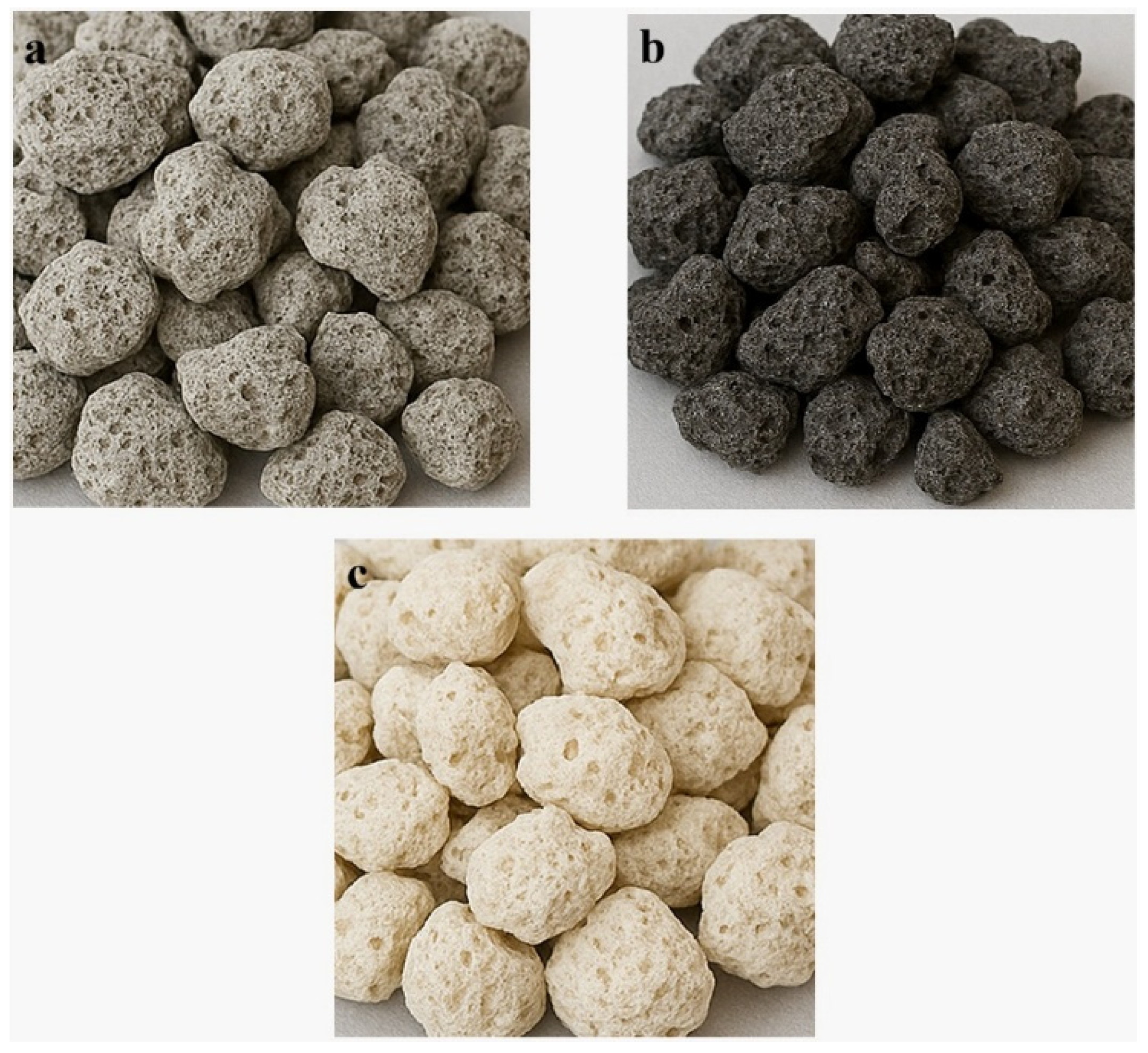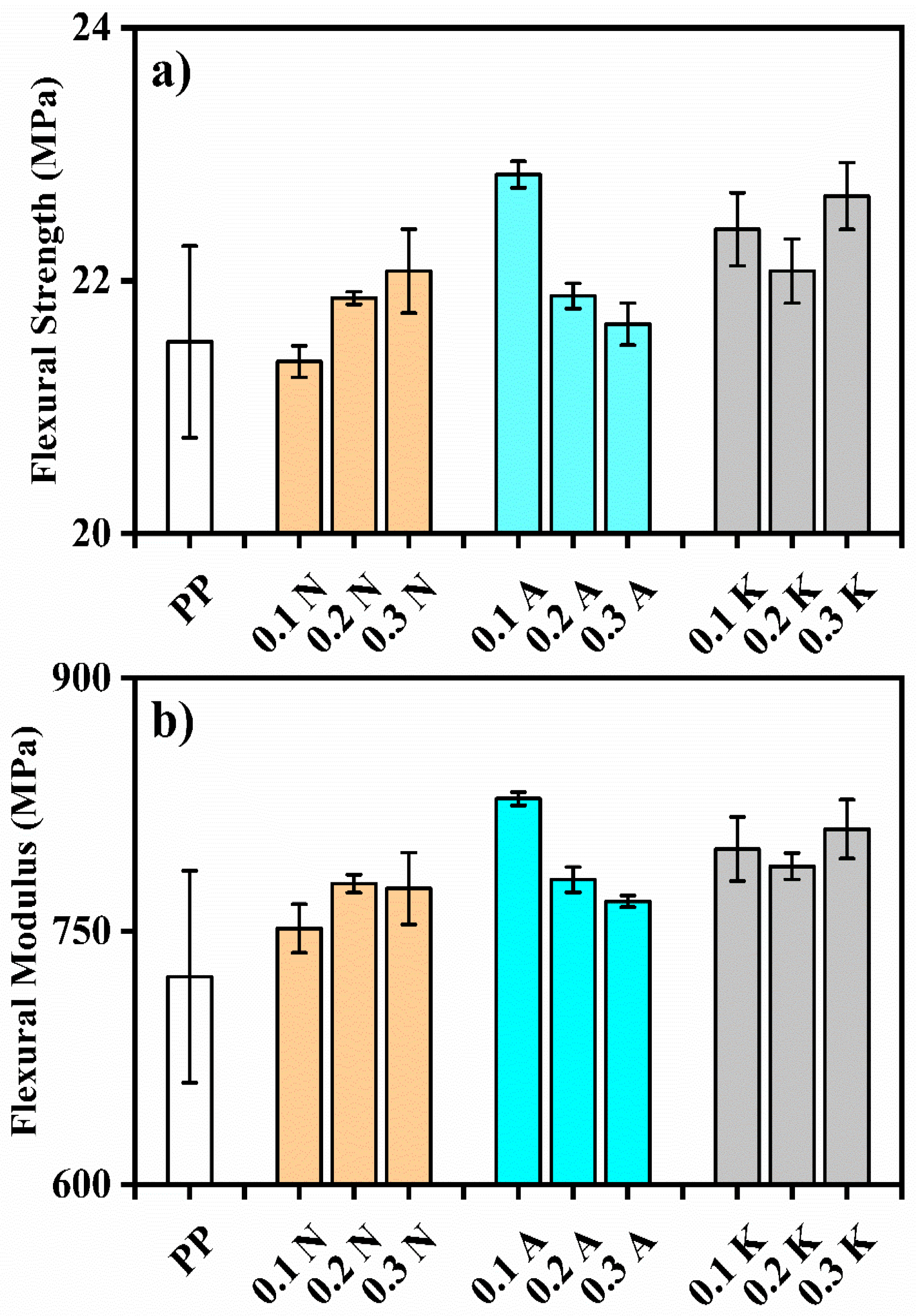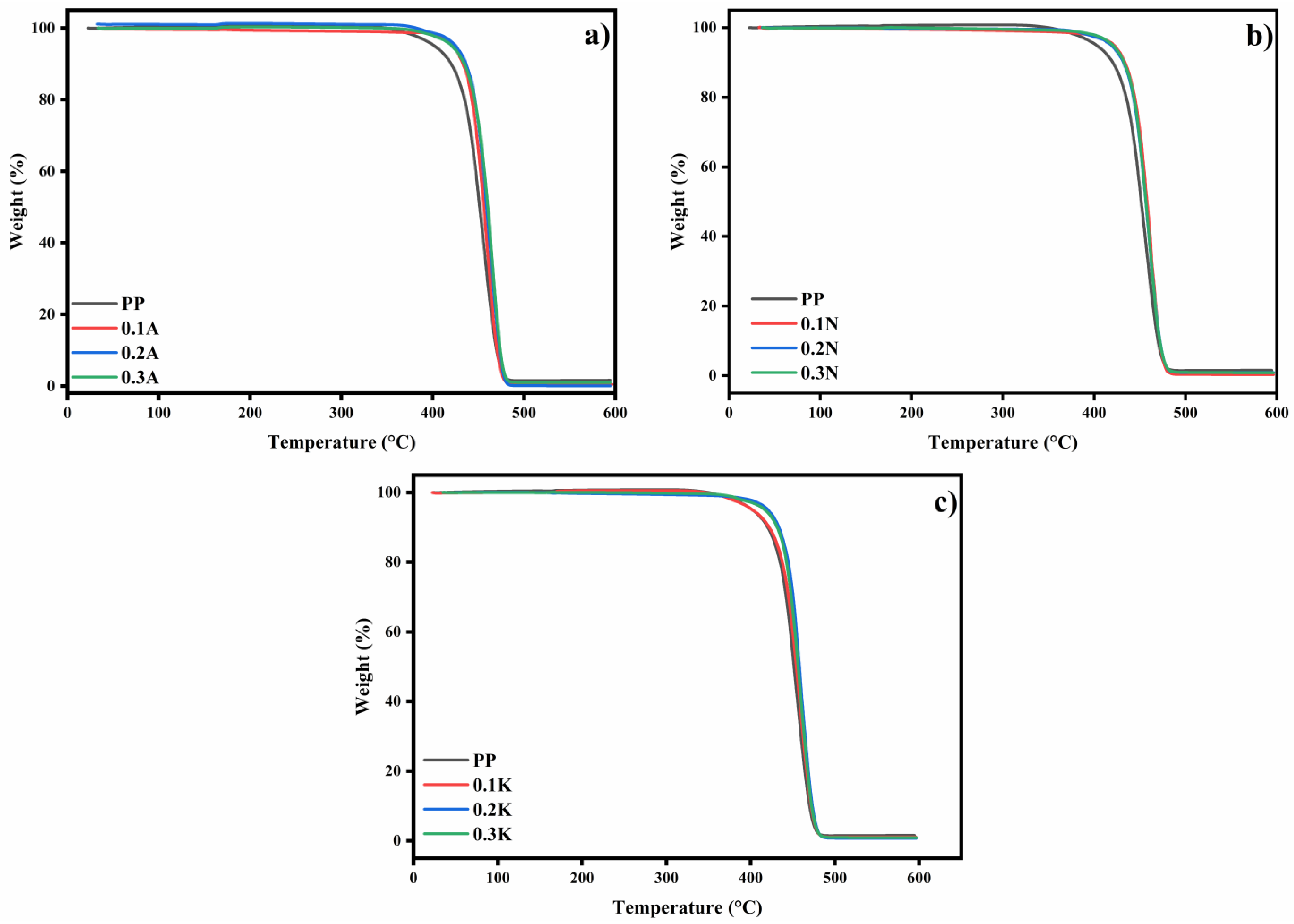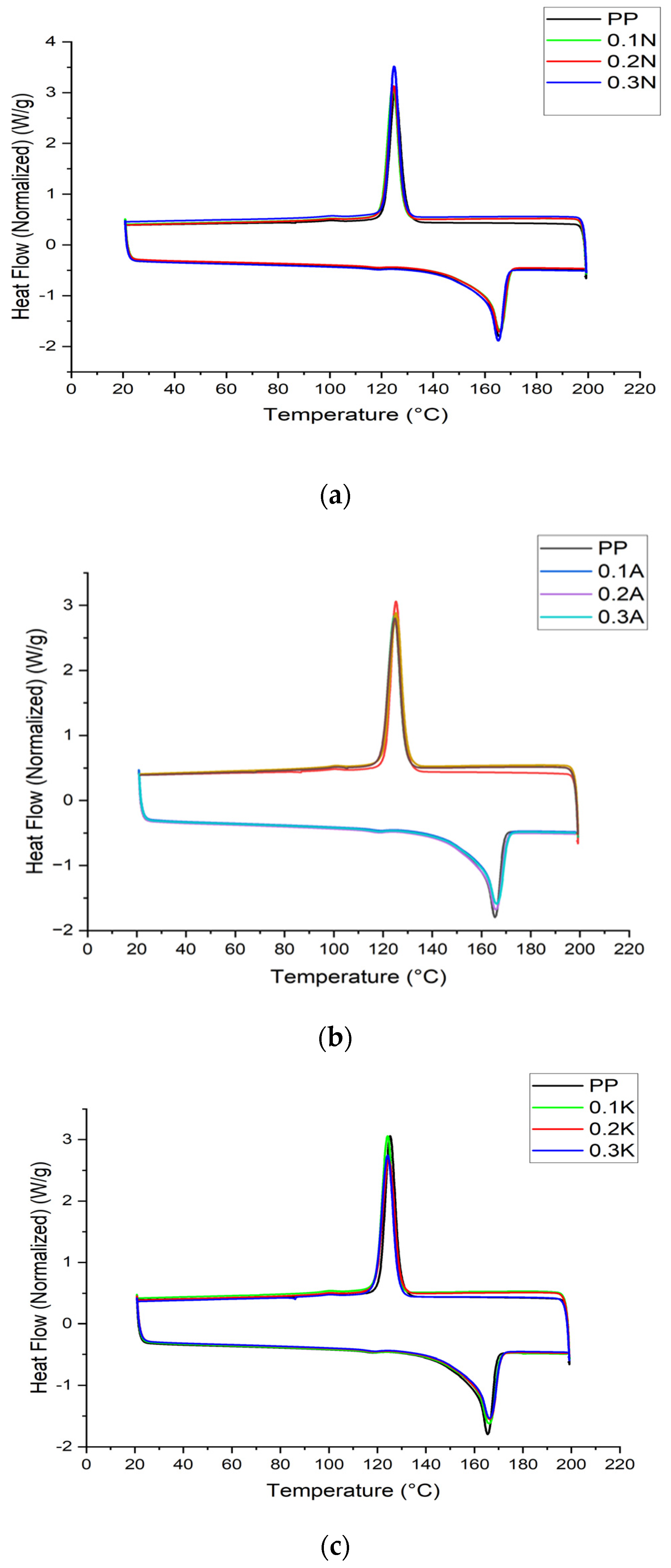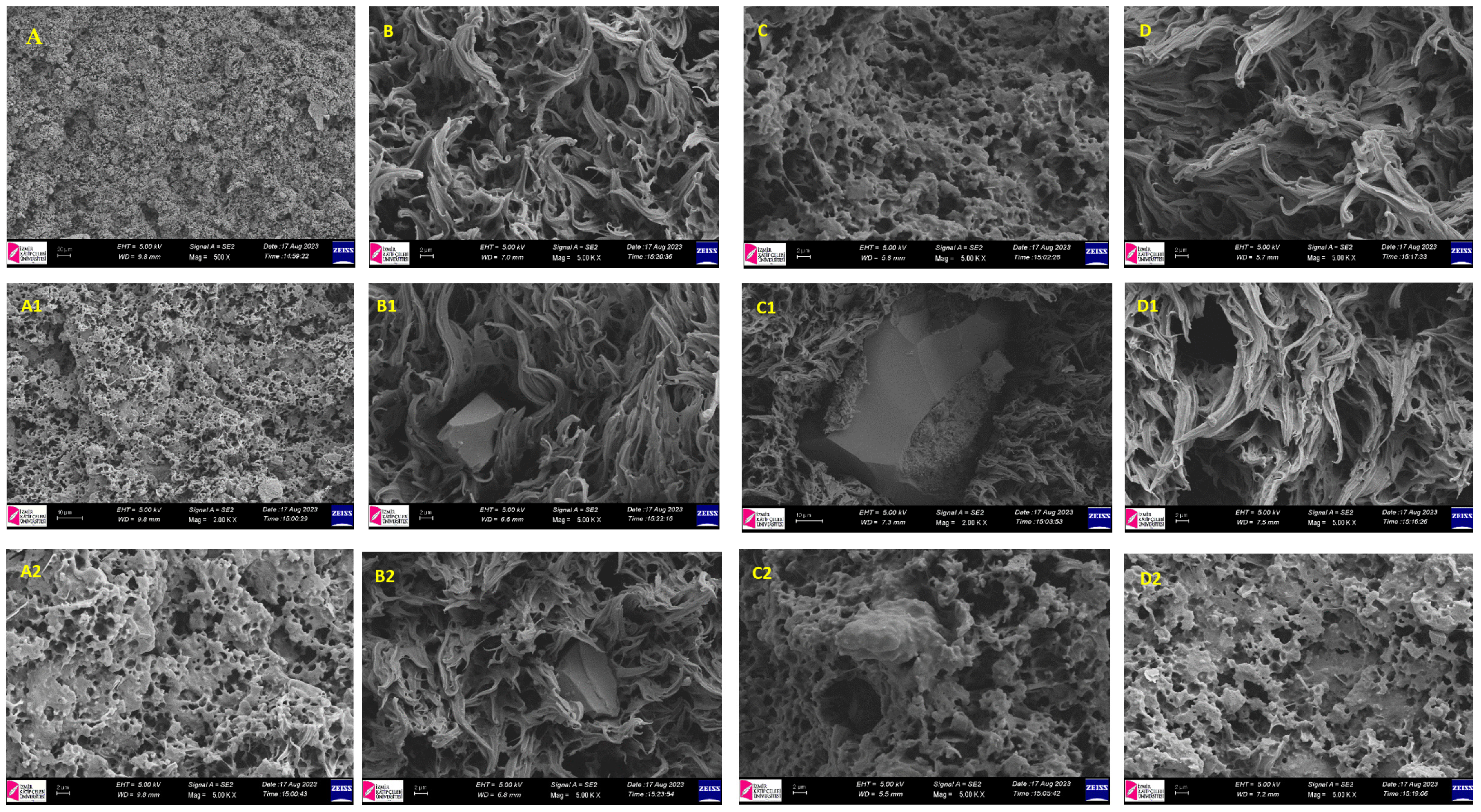1. Introduction
Engineering material advancements drive technological innovation. Polymer composites have become increasingly common in recent years due to their numerous advantages over traditional materials. These lightweight composites offer significant benefits across various industries, including rail, automotive, and aerospace, particularly through reduced fuel consumption [
1]. In recent decades, the polymer industry has shown growing interest in the use of fillers. The incorporation of fillers significantly enhances polymer properties, including flexibility, impact resistance, tensile strength, abrasion resistance, and thermal stability [
2,
3,
4]. Various fillers, including pozzolanic wastes, mineral fillers, and agricultural wastes, have been employed to achieve desired material properties. Researchers have extensively studied how filler characteristics—including type, size, content ratio, and filler-matrix adhesion influence the mechanical properties of polymer composites [
5].
Polypropylene (PP), a versatile thermoplastic polymer, finds extensive applications due to its advantageous properties, including low cost, low density, excellent processability, and recyclability [
6]. However, its limited fracture toughness presents challenges in specific applications. One effective approach to overcome PP’s limitations involves using heterophasic ethylene–propylene copolymers (EPP), comprising a semi-crystalline isotactic PP homopolymer matrix with a dispersed soft ethylene–propylene rubber (EPR) phase [
7]. While the strategically distributed elastomeric phase enhances toughness and low-temperature impact resistance, it adversely affects material rigidity [
8]. Therefore, to achieve an optimal balance between toughness and stiffness, researchers have modified the polymeric matrix using moderate amounts of hard nanoparticles [
9].
Orthorhombic (γ), hexagonal (β), and monoclinic (α) crystal modifications are all present in PP, a semicrystalline and polymorphic material. The low impact resistance of PP limits its potential as an engineering polymer, even though it has outstanding ductility and stiffness, excellent resistance to chemicals and moisture, and better processability. Although PP toughening by adding tiny particles, including ethylene–propylene rubber and polyethylene-octene elastomer copolymer, has been the subject of many investigations, the rubber toughening method usually reduces the modulus and strength of PP. In order to simultaneously improve strength and toughness, recent research has concentrated on ternary systems that combine rubber with hard inorganic fillers (such as talc, calcium carbonate and silica). However, mismatching parameters like component miscibility, phase structure, and phase size can significantly impact the composite’s mechanical properties. Notably, β-form PP (β-PP), produced using specific β-nucleating agents (β-NA), demonstrates superior impact strength and heat distortion temperature compared to α-form PP (α-PP) [
10,
11,
12].
Nucleating agents, when incorporated into plastics, form nuclei for crystal growth in polymer melts. In PP, these agents enhance crystallinity and create more uniform crystalline structures through additives such as adipic and benzoic acids or their metal salts. They usually decrease processing times while improving physical characteristics and, in the case of α-NAs (clarifying agents), improving aesthetics. PP nucleating compounds fall into two categories: α-nucleating agents inducing α-phase crystallization and β-nucleating agents promoting trigonal β-phase formation. Common α-NAs include talc, kaolin, and sodium benzoate, while β-NAs comprise substances like pimelic acid with calcium stearate and triphenodithiazine [
13,
14].
The impact of pumice as a nucleating agent on the mechanical and thermal properties of PP is examined in this work. During rapid lava cooling, dissolved gas precipitation gives pumice, an amorphous, porous volcanic rock mostly made of SiO
2, its distinctive porous structure [
15]. Türkiye, possessing nearly 3 billion m
3 of reserves, ranks as the world’s fifth-largest pumice producer after Italy, Greece, China, and Iran [
16]. The material exists in two forms—acidic and basic pumice—with acidic pumice being predominant both in Türkiye and globally. Pumice’s porous surface shape and changeable acidity (acidic/basic character) can significantly affect filler–matrix interactions and crystallization behavior in PP, making it especially appropriate for polymer reinforcement in addition to its availability [
17].
Pumice is useful in construction applications, especially in lightweight brick and concrete parts that provide thermal and acoustic insulation, because of its high porosity, which leads to a low apparent density (0.35–0.65 g/cm
3) in aggregate form [
18]. Studies have looked into pumice’s potential as an adsorbent for both organic (such as phenol and textile colors) and inorganic (such as various heavy metals and radioactive elements) water contaminants, expanding its usefulness beyond its usual applications [
19,
20,
21,
22,
23].
Despite these applications, the use of pumice as a nucleating agent in PP has rarely been addressed in the literatüre [
24], making it a novel low-cost alternative compared with traditional nucleating agents like talc or silica [
25]. Compared to other natural nucleating agents such as talc and silica, pumice offers unique advantages in terms of abundance, low cost, and a highly porous surface morphology that can facilitate mechanical interlocking with the polymer matrix. Moreover, unlike talc, which has raised environmental and health concerns regarding occupational exposure (e.g., respirable dust), pumice is generally considered a safer and more sustainable alternative [
25].
Furthermore, pumice deposits differ by region in mineralogical composition, porosity, and surface chemistry [
26,
27,
28], which are critical factors for nucleation [
29]. Compared to other natural nucleating agents such as talc, silica, and zeolite, pumice offers unique advantages in terms of abundance, low cost, and porous surface morphology. Moreover, unlike talc, which has raised environmental and health concerns in occupational exposure, pumice is considered safer and more sustainable.
Although talc, silica, and zeolite have been widely studied as nucleating agents, most of these are synthetic or relatively costly, while pumice represents an abundant and sustainable natural resource [
25]. To date, however, a systematic comparison of pumice from different geographical regions in terms of nucleation efficiency has not been reported [
28]. The mineralogical characteristics of pumice, including silica content, porosity, and acidic/basic nature, are critical parameters that directly influence filler–matrix interactions and nucleation. For instance, acidic pumice with higher SiO
2 content may promote stronger interactions and faster nucleation, while basic pumice, containing more alkaline oxides, tends to weaken interfacial bonding. Therefore, understanding regional mineralogical differences is essential to evaluate pumice as a functional nucleating agent in PP.
Therefore, the central research question of this study is how regional variations in pumice mineralogy, surface chemistry, and particle size influence nucleation behavior, crystallization kinetics, and the mechanical/thermal properties of PP composites.
By employing pumice from three distinct regions in Türkiye (Nevşehir, Alaçatı, and Kütahya), this work aims to fill this gap and provide the first comprehensive assessment of natural pumice as a functional nucleating agent in PP [
24,
30,
31].
3. Characterization
3.1. Particle Size Analysis
Particle size distributions were measured using two different instruments: a Malvern Panalytical Ltd., Newland, UK, Master Sizer Hydro 3000 for the initial ground pumice (<100 microns) and a Malvern Panalytical Ltd., Newland, UK, Nano ZS for the fine particles (<10 microns) obtained after secondary grinding. In applications where granules are implemented, particle size is among the most critical attributes. Particle sizes in dry and wet samples can be measured using the Malvern Nano ZS instrument from the nanometer to the millimeter range.
3.2. Thermogravimetric Analysis (TGA)
Using a TA Instrument Q600, New Castle, DE, USA the thermal decomposition characteristics of PP and its composites were assessed. Under a nitrogen environment, samples were heated from ambient temperature to 600 °C at a rate of 10 °C per minute.
3.3. Differential Scanning Calorimetry (DSC)
A TA Instruments DSC Q2000, New Castle, DE, USA in a nitrogen environment was used to characterize the thermal characteristics. Heating from 20 °C to 200 °C at 10 °C/min, isothermal holding at 200 °C for 3 min to remove thermal history, and cooling to 20 °C at 10 °C/min, followed by a second heating cycle to 200 °C at 10 °C/min, were the three processes making up the analysis. These measurements were used to calculate the melting and crystallization temperatures as well as the corresponding enthalpy values.
3.4. Heat Deflection Temperature (HDT)
HDT tests were performed on an Instron, Norwood, MA, USA, Ceast HV3 model device standard under a specific load of 1.8 MPa.
3.5. X-Ray Diffraction (XRD)
A Bruker, Billerica, MA, USA, D8 Advance Diffractometer fitted with a Ni-filtered CuKα radiation (λ = 1.54 Å) was used to obtain the XRD patterns. Every sample was measured in the 2θ angle range of 5° to 50°. The scan step time was 10 s, and the step size was 0.03 s. A voltage of 45 kV and 10 mA of current were utilized.
3.6. Mechanical Properties
Tensile properties were evaluated according to ISO 527 using a Shimadzu, Koyoto, Japan, Autograph AG-IS universal testing machine equipped with a 5-kN load cell at a crosshead speed of 50 mm/min. Flexural properties were determined following ISO 178 using three-point bending tests with a span length of 64 mm and a crosshead speed of 1 mm/min. Impact resistance was assessed using an Instron, Norwood, USA Ceast 9050 impact tester with a 5.5 J Izod hammer. All mechanical tests were performed on five specimens per composition (
n = 5), and the results are reported as average values with standard deviations [
33].
3.7. Scanning Electron Microscopy (SEM)
The composites’ fracture surfaces were inspected with a Carl Zeiss, Oberkochen, Germany, 300VP scanning electron microscope set to 2.5 kV. To avoid charging effects, samples were covered with a thin layer of gold using an Emitech, Trappes, France, K550X automatic sputter coater before being observed.
Scanning electron microscopy (SEM) was used to investigate the fracture surfaces of tensile and impact specimens. Special attention was given to filler dispersion, agglomeration size, and interfacial voids in order to understand the interaction between pumice particles and the PP matrix.
5. Conclusions
This work provides the first systematic evaluation of pumice powder as a nucleating agent in polypropylene, revealing its potential to simultaneously improve toughness and thermal stability. The powder was sourced from three distinct districts of Türkiye: Nevşehir, Alaçatı, and Kütahya. Using sophisticated analytical methods like as TGA, DSC, XRD and SEM, the study concentrated on determining the mechanical and thermal characteristics of these composites. The results show that pumice successfully increases heat stability and PP’s crystallization behavior. Nevşehir pumice showed the best nucleating effect among the investigated samples, increasing HDT, Young’s modulus, and tensile strength. In contrast, the pumice samples from Alaçatı and Kütahya showed fewer homogeneous structures, which resulted in higher porosity. This, in turn, affected mechanical characteristics, including flexural strength and impact resistance.
With greater Td and Tmax values seen in all composite samples, thermal analysis verified that the addition of pumice improved PP’s resistance to thermal degradation. However, the type and concentration of pumice affected the improvement level. Higher filler loadings occasionally caused agglomeration, which impacted toughness and elasticity, but lower concentrations often produced greater impact resistance and more uniform dispersion. The deterioration of impact strength at 0.3% loading for most samples suggests that concentrations exceeding this value (e.g., 1%) would likely lead to severe agglomeration and further reduction in toughness, outweighing any potential gains in stiffness or thermal stability. Pumice appears to be a viable, low-cost, naturally occurring nucleating agent for polypropylene composites. Its use can increase mechanical performance, thermal stability, and perhaps decrease production expenses by replacing traditional fillers. All things considered, pumice shows promise as an inexpensive, environmentally friendly, and locally adjustable PP nucleating agent, with immediate ramifications for industrial uses in the consumer goods, automotive, and packaging industries. Future research should focus on two main avenues: optimizing pumice particle size and surface treatment to improve dispersion, and employing advanced characterization techniques such as isothermal crystallization kinetics (e.g., the Avrami equation) to quantitatively elucidate the nucleation efficiency and crystal growth geometry induced by the distinct pumice types.
